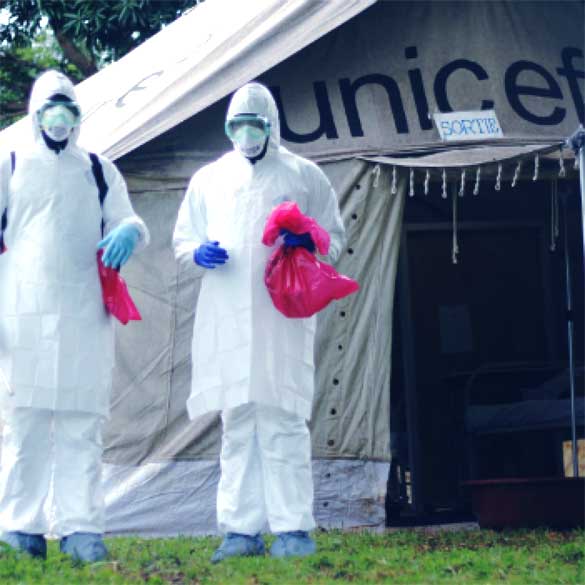By ERIC NGANG
[dropcap]T[/dropcap]he Millennium Development Goals (MDGs), a common set of development targets that have influenced the priorities of many governments, donors, development agencies and other development stakeholders were adopted by 189 world leaders from rich and poor countries, as part of the Millennium Declaration which was signed in 2000. There is a flurry of stakeholder discussions and consultations towards establishing a new set of goals to replace the MDGS as the 15 years period set for this global development vision elapses by the end of 2015.
There is significant global disparity in the achievement of these goals with countries in Sub Saharan countries recording low in most evaluations and surveys. This has been partly due to the fact that these broad international policy agendas have not been fully translated into concrete actions tied to regional and national realities in the different target sectors that are drivers of global development including environmental sustainability. In most of the discussions geared towards arriving at proposals that would inform the post-2015 agenda, there have been calls for more obligations on rich countries in areas such as climate change and resource consumption. In this investigative article, the water sector is considered important given that its importance to the ecosystem and human health.
It is observed that six out of the eight MDGs are directly or indirectly hinged on the availability of water and the factors that affect its availability including climate change and population growth as depicted in table 1 below, adapted from a UN 2006 report. However, at eave of the deadline of the MDGs, renowned global reports on the evaluation of targets in this sector have been overly stated, given that access to the resources continues to fall especially in Sub Saharan Africa.
- When the world is preparing to adopt post-2015 sustainable development goals (SDGs), a renewed thinking about availability of water for future generations using a sustainability thinking that focuses on both humans and natural systems is crucial.
- It is observed that the focus on availability of water for future generations, in the face of climate change and population explosion, has been on ensuring human wellbeing with little regards for other environmental or ecological systems.
| MDGs | Direct relation to water | Indirect relation to water |
| Goal 1:Eradicate extreme poverty and hunger |
|
|
| Goal 2:Achieve universal education |
|
|
| Goal 3: Promote gender equity and empower women |
|
|
| Goal 4: Reduced child mortality |
|
|
| Goal 6: Combat HIV/AIDS malaria and other diseases |
|
|
| Goal 7: Ensure environmental sustainability |
|
Develop operation, maintenance, and cost recovery system to ensure sustainability of service delivery |
Table 1: This table depicts direct and indirect links between 6 out of the 8 Millennium Development Goals (MDGs), water management and climate change.
Linking water availability to climate change and human development
Many renowned scientists and institutions including the Intergovernmental Panel on Climate Change have indicated that the combined effects of climate change, population growth and development will most likely affect the future state (quality, quantity, location, reliability of supplies) of this finite water resource. The growth in the world’s population from 300 million, 2000 years ago, passed 1 billion in 1800, 2 billion in 1930, 6.5 billion in 2006, 7 billion in 2011, and projected to reach 13 billion in 2050 places additional strain on this finite resource. Water scarcity is projected to get worse in the coming decades and beyond, given this projected growth in world’s population associated with accompanying socio-economic demands for urbanisation, household and industrial uses.
Against this backdrop, recent national and global summits have echoed the need for targets to meet the global demand for water. For example, emphasis on drinking water was a top priority in the MDGs goal 7. The MDG goal 7 seeks to ‘ensure environmental sustainability’ and targets “reduction by half the proportion of people without sustainable access to safe drinking water and basic sanitation”. The UNDP Water Supply, Sanitation and Hygiene (WASH) programme, was developed, with the aim of fast-tracking the realization of this specific goal. Furthermore, the 2002 World Summit on Sustainable Development in Johannesburg South Africa and the UN International Decade for Action – Water for Life 2005-2015 reiterates the need to respect the set targets in order to meet the global demand.
What Progress has been made so far towards the attainment of targets on water within the framework of MDG7?
Broadly speaking, given the wide mobilisation towards meeting global targets in the water sector, some global institutions have posited that positive results have been achieved. For example, the WHO and the UNICEF Joint Monitoring Programme (JMP) for Water Supply and Sanitation, indicated that between 1990 and 2010, more than 2 billion people gained access to improved drinking water sources, such as piped supplies and protected wells (JMP, 2013). Based on the JMP household survey, by the end of 2010, 89% of the population representing 6.1 billion people used improved drinking water sources. This represented a 1% more than the 88% target contained in the MDG7 set in 2000.
A 2010 UN report indicates that the international target to halve the number of people who do not have access to safe drinking water was attained five years before the 2015 deadline (MDGs Report, 2012). Despite the echoing of these very positive results, the JMP which is the official United Nations mechanism tasked with monitoring of the progress towards the attainment of the MDG7 focusing on the water sector in their 2013 report asserts that measuring access and testing the quality of the water at national levels including local levels in all countries was extremely expensive and logistically difficult (JMP, 2013). Thus it is likely that the number of people using safe water supplies was overestimated in these internationally acclaimed reports. In addition, regional disparities exist in the assessments as could be seen in the challenges faced by many Sub-Saharan African countries recently in the water sector.
For example, Cameroon, like some of its peers in Africa, still lags behind targets set for the achievement of the MDGs on access to water and related sectors. In this Sub Saharan African country, from, June 2012 till date, unlike the traditional belief that urban populations globally have access to improved water supply sources, the issue of inaccessibility was glaring during this period resulting in serious unrest especially in the main political and economic cities of Yaounde and Douala and other regional capital cities including Bamenda and Buea where the urban rich live.

- Physical and Economic Water Scarcity Around the World. Source: World Resources Institute
This falls in line with reports from many global institutions including the World Bank, that are at the forefront, working with local and national institutions to ensure access to the resource. These institutions report that the proportion of urban residents with access to water have been recurrently low and in many cities it is continuing to fall at an alarming rate. The validity of these internationally acclaimed reports have also been put to question by the UN’s Secretary General Ban Ki-moon during the 2013 United Nation’s International Day of Biological Diversity when he indicates that:
“Although seemingly abundant, only a tiny amount of the water on our planet is easily available as freshwater. We live in an increasingly water insecure world where demand often outstrips supply and where water quality often fails to meet minimum standards. Under current trends, future demands for water will not be met”.
Ban Ki-moon calls for a “mutually reinforcing” relation between other sectors especially as the MDGs shall be replaced by a post 2015 agenda including a new set of goals for sustainable development.
Why reflect on who and what constitute the “future generations” in the context of water availability amidst threats of climate change and rapid population growth?
Significant inroads have been made towards enhancing global access to water and sanitation as enshrined in the MDGs. However, using a sustainability approach that takes into consideration all the facets of sustainability, it is observed that focus on enhancing the availability of water for future generations has been focused on the water needs to enhance the current and future socio-economic wellbeing of humans, neglecting those of environmental systems, whose future survival equally depends on availability of water and which must survive in their own right.
In looking at threats to availability of water for future generations, it is important to consider the question “who” and “what” constitute the future generation. This calls for a reflection that puts into perspective a sustainability framework – one that gives a balanced perspective on the economic, social, and environmental concerns in relation to the crucial players and systems in the water sector.
It is observed that the focus on availability of water for future generations, in the face of climate change and population explosion, has been on ensuring human wellbeing with little regards for other environmental or ecological systems. However some authors have argued that the costs of impact of climate change and population growth on these ecological systems is more complicated because these environmental systems produce goods and services (nutrient uptake and cycling, primary and secondary production, decomposition, and interactions in the food web) that are not priced in markets.
This is further compounded by the fact that standard economic analysis often underestimates humans’ stake in the health of natural resource systems, with climate-induced change exacerbating challenges to get a satisfactory balance between human water uses and environmental water needs. There is thus a visible competition between water needs of these ecosystems and human uses.
Human’s contribution to the significant ecological irreversible damage is often looked at as an issue of long term sustainability and that raises the issue of substitutability of damaged environmental resources and meeting the needs of future generations of the same resources. This challenges the Brundtland definition of sustainability coined during the 1987 World Commission on Environment and Development, which to an extent fails to take into consideration the finite nature of natural resources and defines sustainable development as one which ‘meets the needs of the present generations without compromising the ability of the future generations to meet theirs’.
It is thus clear that in talking about future generations in the context of water availability; both human and environmental systems, whose present and long term survival depends on availability of water, have to be taken into consideration. As a result, due consideration for the water needs of natural environmental systems needs to be given as they are entities that must survive in their own right.[/vc_wp_text]
Thus a renewed thinking about availability of water for future generations using a sustainability thinking that focuses on both humans and natural systems is crucial at the moment when the world is currently reflecting on development goals that shall serve as signpost, guiding development post 2015.
(Eric Ngang is GSDM’s Special Correspondent for Global Environment and Climate Change and also the Founder/CEO of Action Group on Governance and Environmental Management)











